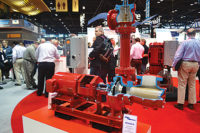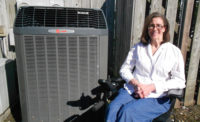Mascots, when properly deployed, can be a great asset to your business. Just ask the companies behind Mr. Peanut, the Energizer Bunny, or, most recently, the Aflac duck. The well-known characters have helped create brand awareness among consumers. According to Dan Antonelli, president and creative director, Graphic D-Signs Inc., Washington, New Jersey, retro-branding with character logos and mascots is becoming a hot commodity.
“It definitely works,” Antonelli said. “Mascots serve as a point of recognition. People associate a symbol or mascot with a company much quicker than they do a simple message. A lot of heating and air conditioning companies use generic icons such as the sun/snowflake graphic or something red and blue that doesn’t necessarily stand out in the sea of graphics competing for peoples’ attention. When you add a mascot, it tends to make the brand warmer. People seem to connect with them a little bit more on an emotional level than something that’s more generic or cold and corporate.
“It’s certainly something that, when implemented, serves as a means to break out from the clutter because it’s not a strategy that is widely deployed on the service sector,” he continued. “We do it a ton, but if you look at the landscape, it’s not something that’s completely mainstream in terms of branding for service companies.”
Antonelli’s company has designed more than 100 character logos and mascots for HVAC companies. The mascot approach is not for everyone, Antonelli cautioned. First off, contracting businesses need to determine their core target audience, demographics, and what appeals to them. “If you look at a service business that’s focused highly on doing commercial air conditioning or refrigeration work, a mascot approach may not be the best strategy because they are dealing with more corporate-type clients and facility managers.”
REBRANDING SMALL BUSINESSES
Harrell King Heating & Air, located in Bainbridge, Georgia, enlisted Antonelli to completely rebrand its business. Through the rebranding process, the 32-year-old heating and cooling company brought to life the Komfort King.
“They [the mascots] go to different community events, ball games, and parades and hand out things from the company,” Antonelli said. “The company has an aggressive publicity campaign around the appearances the mascot makes, which helps to make the brand warmer and more approachable. A lot of service businesses really underestimate how important some of those community events are.
“Things like sponsorships for soccer or baseball teams are great touch points,” he added. “When parents are taking pictures of your mascot with their kids, you can’t put a value on that in terms of the advertising benefits.”
Mike Albritton, sales and marketing manager for Harrell King, said, originally, the company was not interested in rebranding. Initially, it was just looking for a vehicle-wrap design.
“We found a few local people who did vehicle wraps, and what they shot back to us was just absolutely terrible,” Albritton said. “Then, we saw an award-winning vehicle wrap in a magazine and contacted the company. After shooting Dan [Antonelli] our logo, he came back and said it was really weak, that he couldn’t work with it. Of course, my first thought was he was just trying to sell me something. I told him we weren’t interested in more and just do what we paid for. He then shot back and said, ‘We’re not interested.’ And, once he said that, he had my attention.” Albritton began to look at Graphic D-Signs’ portfolio and was impressed. The company decided to let Antonelli start from scratch and rebrand from the ground up.
“When he got done with everything, we really loved our little guy,” Albritton said. “I thought we could really market this thing.
“When I said we needed a mascot, it was kind of a joke. People said I was crazy, that it wouldn’t work, but I knew we could build a theme for kids around it.”
However, after being told it would cost about $6,000 for the mascot suit, Albritton laughed it off. “But, then, I really thought about it,” he said. “If we’re going to jump out into our communities, what better way to do it? We’re in small, rural Georgia. Every community we serve still has homecoming and Christmas parades. So, we did it. And, it’s crazy, but people have been all over it.”
The mascot, which dons its own tailored suit, attends kids’ birthday parties and parades, and even hosts a field goal contest during Friday night football games. “It came with a pretty big upfront cost, but it’s served us well so far,” Albritton said. “You can’t put a dollar figure on it.”
Harrell King’s sales increased between 23-28 percent during the first year after rebranding. Within two years, the company’s sales increased 34-39 percent, the highest number of sales seen within the company’s 32 years. Harrell King now owns 48 percent of their market share.
“Rebranding, as a whole, is powerful for a company,” Albritton said. “And we already owned a large portion of the market share in our area. We weren’t struggling with the market share; we just gained more of it.”
COMMUNITY MARKETING
Perhaps one of the more recognizable mascots in the HVAC industry is Steve Moon’s Moonman. Moon, who owns Moon Air Inc. in Elkton, Maryland, has had his intergalactic mascot in orbit for 30 years.
“My father had a company in Virginia when I was a boy, and when I decided to open my own company up here in Maryland, I opted for the same name as an ode to his legacy. It started out as Moon Services, so it encompassed everything we could do. And, then, we wanted to try and associate our service more with air conditioning, so we switched it to Moon Air. The Moonman is so well branded here, I didn’t want to give it up. Changing the name to Excellent Air Conditioning, or the like, was never an option.”
Moon ‘stole’ the Moonman logo from his father and put it on his first truck. “Back then, heating and air conditioning trucks looked completely different than they do today. The company name would be on the driver’s door, and that was pretty much it. But, I took it a step further and put my Moonman on our truck as large as I could. This garnered a lot of attention. I only had one truck at the time, but people thought I had more because the truck never went unnoticed. That was my goal.”
The Moonman started out as a logo, but he came to life about 10 years ago when Moon elected to purchase a Moonman suit. A nice suit will cost between $5,000 and $10,000, Moon said. “I contacted one of the companies that does suits for Disney and sent them my logo, and they actually created the Moonman. He’s a living being now. Advertising has changed over the years, but the goal has always been to endear yourself to as many people as possible. A mascot really helps you do that. The Moonman goes anywhere he’s invited, and it’s a big deal when he shows up.”
According to Moon, the Moonman is lazy and usually only works weekends. The mascot attends all of the local fairs, car shows, carnivals, and parades. He also attends kids’ birthday parties, which are a big deal, Moon noted.
“When the Moonman shows up, the parents have free entertainment, which they like — a lot. All the kids want their pictures taken with the Moonman, so we take the pictures. And, while they’re having their party, the ground crew runs back to the office and prints out all these pictures. Then, they go back to the party and give all the kids their picture with the Moonman in a little magnetic frame with a little service coupon. Who’s going to throw away a picture of their kid? I’m on refrigerators all over the county. It’s my aim to put the Moonman, and our phone number, in as many places as I can.”
Moon even has temporary Moonman tattoos he hands out to kids at events. He’s even had people ask if they can have the mascot permanently tattooed on their bodies. “I’m like Harley Davidson; I’m all over the place.”
Moon agrees with Albritton in that it’s hard to measure return on investment (ROI) when using a mascot in community engagement and marketing.
“Let me put it this way: We went to a car show one weekend and the Moonman took a picture with a guy. On Monday, we sold that guy a system for $7,000. These things happen, and it’s really hard to monitor or explain.”
Moon added that if you plan on using a mascot, you have to be willing to put the community marketing time in.
“A mascot is only going to be good if it’s a public figure,” Moon noted. “If you buy a suit and just sit it in the closet, it’s not making you any money. It doesn’t do anything for you. And, if you’re in a major metropolitan area and you’re not doing events and things, there’s no reason to have a mascot. But, if you’re in these small communities, where you’re fighting for those leads, a good, well-trained mascot can be highly beneficial.”
In explaining himself, Moon put an added emphasis on the phrase “well-trained.”
“Mascots need to know how to act, and, yes, there are rules,” he said. “We were at an event the other day and these two mascots took their suits off right in public. A trained mascot would never do that. If the kids see it, it’s the equivalent of Santa Claus taking off his beard. You just don’t do it. A mascot also has to be really dynamic in its movements, because a mascot is never, ever supposed to say a word. Some people just don’t get this, and their mascots are talking. The kids are smart — they know there’s a person in there. Everybody wants to market to 40-year-old homeowners who can afford an air conditioning system. I market to 4-year-old children because they have those people attached to them. If I get the kid’s attention, and the kid loves me, the parent will love me, or at least give me a shot.”
CHANGING WITH THE TIMES
Snyder Heating & Air Conditioning of Jacksonville, Florida, took a slightly different route when designing its character logo and mascot, opting for the ever-popular Snyderman superhero, which was born in 1991.
“We were starting our advertising campaign, and we had an advertising group working on it,” said Ed Miller, president, Snyder Heating & Air Conditioning. “They came up with a jingle, and part of the jingle was, ‘Snyderman can.’ Then, they said we needed to have a character. I was one of the first people to say it was cheesy and corny, and I didn’t think it would be something that would really fit. Looking back, I’m glad we did it.”
After more than 20 years of attending community events, Snyder Heating & Air Conditioning decided it was time to upgrade their mascot’s look.
“The old Snyderman costume had tights with the bloomers over the top, much like the old Superman and Batman costumes,” said Tim Wood, area supervisor, and the man who fills the Snyderman costume. “The original Snyderman looked cool, but he was a little bit dated.”
Wood shopped around, looking for somebody to make a professional costume and came across IronKlad Studios in West Hollywood, California.
The company has worked on many popular movies, including “Guardians of the Galaxy,” “Iron Man 3,” “Dawn of the Planet of the Apes,” “Maleficent,” and even made the new Batman costume in “Superman vs Batman: Dawn of Justice,” set to release in 2016, according to Wood.
“Right off the bat, the crew was pretty impressive since they operate a feature film studio,” Wood said. “They can also create commercials. We went with them because they have top-notch designers and because of the possibility of future endeavors.”
The new Snyderman suit cost $10,000 and features more muscles and detail than the old costume. “This one is a little more updated to match the Hollywood portrayal of the superhero costume,” Wood said. “The one we had served us really well, but it had one little chest piece that showed muscle definition. Now, it’s got a nice, modern look, and it’s super clean.”
Snyderman reaches out to kids and adults alike, said Miller. “When technicians go up to customer’s doors, they ask, ‘where’s your cape?’”
Dressed as Snyderman, Wood participates in school, community, and charity events. He once even dressed Snyderman as a zombie to participate in a city-wide zombie chase.
“It gives us a chance to give back to the community in a positive way,” he said. “Who doesn’t want to be a superhero? It’s cool to put on the costume and take on that persona. And, around the company, the guys may rib you a bit, but, still, everybody is very excited when Snyderman arrives. It’s fun to put on the costume and be him for a day.”
SIDEBAR: BEST PRACTICES WHEN DEPLOYING MASCOTS
Contracting businesses need to be careful when choosing a design firm to create the artwork for their mascot/logo, said Dan Antonelli, president and creative director, Graphic D-Signs Inc., Washington, New Jersey.
“The artwork we create is original — it’s not based on clipart,” Antonelli said. “This allows your business exclusive rights to that particular graphic, and you can trademark it when we’re done. Companies whose artwork is based on clipart have no recourse in protecting their brands because those images are largely available through public domain. They have no legal recourse against another company. A unique brand is so important because you can defend it if someone else tries to use it or steal it.”
Another point to consider is the artwork being presented to you as original could be infringing on someone else’s trademark, Antonelli noted. “We’ve had our client’s artwork put on crowdsourcing sites as something someone else designed. We’ve had to send out cease-and-desist letters.”
Additionally, businesses should ensure their mascots are rendered in the exact same style, whether it’s the company’s uniforms, business cards, website pages, or vehicle wraps. “Consistency of how you integrate the mascot is very important. You don’t want to have different versions or interpretations of your character. We really stress that, no matter where the consumer might interact with him, your brand communicates the same, regardless.”
According to Antonelli, a mascot-bearing company must ensure the mascot can be transposed to the company’s fleet of vehicles.
“You have to make sure the artwork works when scaled up to that large size,” he said. “A lot goes into the consideration of how thick the strokes are that make up the mascot, the line weight, and how those things are going to translate on a larger scale. The viewing distance from the trucks ranges 10-50 feet, or more. How well those details translate on a larger scale is very important, and, often, those images fail to work when the designer doesn’t have an understanding of the outdoor realm.”
Publication date: 6/22/2015
Want more HVAC industry news and information? Join The NEWS on Facebook, Twitter, and LinkedIn today!











